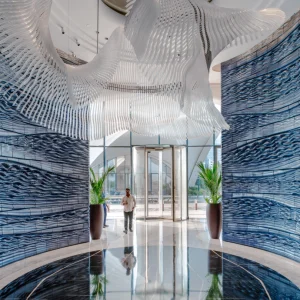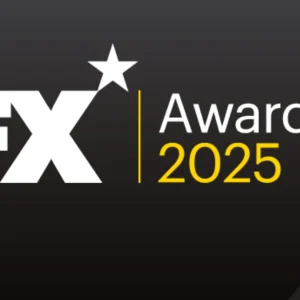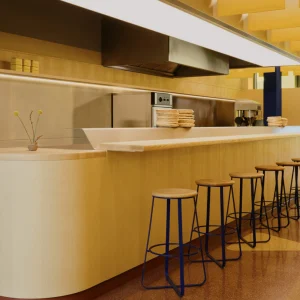Edited by Scarlett walker-hebborn
What has been the most significant improvement in office design over the past 30 years?
Over the past 30 years there have been huge industry shifts in the way we design offices, as a direct reaction to the economy, technology and the most recent global pandemics. In my opinion, the influence that hospitality design has had on the workplace is the most significant or impactful to the way we design and want to occupy our office space. Coming from a hospitality design background myself, I believe this shift has brought a sense of place and community engagement that was lacking a decade ago. We’ve moved beyond merely designing functional and utilitarian rows of desks; now, we create spaces that reflect a brand’s identity and bring employees together. Whether it’s working in communal areas or socialising around well-designed tea points, the focus is on fostering a sense of belonging.
Simultaneously, we’ve started paying more attention to the details. Adding a layer of decorative accessories complements the awards and accolades that were once displayed on bare shelves. These decorative objects serve a purpose beyond aesthetics; they convey a familiarity of a residential feel while contributing to the brand’s unique identity. For instance, at JP Morgan’s Technology Campus in Glasgow, we specified unique tapestries to reflect the rich textile history of Glasgow, alongside robot and spacemen sculptures with travel books and plants. This fine (and playful) layer of detail helps tell the story of the brand and locality, while giving warmth to the space.
 Fletcher Priest designed and delivered a contemporary workspace for British Land within Fletcher Priest’s wider refurbishment and refit of 155 Bishopsgate
Fletcher Priest designed and delivered a contemporary workspace for British Land within Fletcher Priest’s wider refurbishment and refit of 155 Bishopsgate
What are the main aesthetic characteristics of a successful office project (or what elements can ruin an otherwise great scheme)?
Success is measured through brand identity and culture, and how these elements are showcased within the design. Consider your first impressions when stepping out of the lifts into the occupier’s space – how does that initial experience translate on impact and how does that continue through the user’s journey into the communal spaces?
However, it’s a double-edged sword. Overbranding and excessive design can undermine an otherwise great scheme, leading to a gimmicky sensory overload, which can negate the values and culture of the business. Now, more than ever, we focus on designing for all types of users. We recognise that neurodiverse individuals may be sensitive to an abundance of colours and branding. While we can’t create a workplace that perfectly suits everyone, we can offer users the option to choose spaces where they want to work. This allows the brand to listen to the users’ requirements and ensures long-term success.
What is it that clients mostly require/request in their projects?
Clients are still trying to get it right post pandemic. There is not a right or wrong when it comes to the future of workplace as that is in constant evolution. Focus spaces, Zoom rooms and quiet spaces for reflection and decompression are at the top of our clients’ wish lists, as well as collaboration spaces.
This ties in a desire to offer agile spaces which best support their staff in having a balanced hybrid work life – for example, fewer desks, and more amenities and collaboration spaces providing a wide range of work settings in the office.
Also, clients are keener now to incorporate biophilia into their offices to boost well-being. We know from workplace index surveys that this has become a leading request from end users, alongside focus areas. However, there should be a balanced curation of greenery throughout the space, which allows the users to connect back to nature in a meaningful way.
Has wellness in the office gone too far – do you design for relaxation at work?
Wellness should be first and foremost – especially in high-intensity jobs where people need a space to decompress. I firmly believe that it is hard to take wellness too far—unless it becomes overly complex and impractical for users.
As ever, we must listen to the users and try to cater for their different needs by offering a wide array of amenities, including multipurpose rooms, mother rooms, prayers rooms and the like. When a company cannot directly provide these spaces, strategic site selection becomes crucial – i.e. choosing buildings that already offer these amenities.
 Irene Georgakis
Irene Georgakis
What current or historical trend has inspired you personally in terms of office design?
Inspiration always comes from multiple trends and shifts. Currently, it’s a mix of both the hotelification of the office and the rise of coworking spaces. Take FORA as an example: they came from a hospitality-focused background, and they helped shift the perception of what an office could be, with layers of curation, management and convenience. By adding gyms, yoga studios or a concierge service, going to the office has become an experience – very similar to when you check into a hotel.
Which exhibitions do you visit for inspiration/research?
Personally, I get most of my inspiration from my travels, which I consider an exhibition of sorts. I learn how people live, how they go to the office, how they occupy space, and what they do differently. I take that culture and bring it back. However, if I were to choose an exhibition, it would be either The Turbine Hall at the Tate Modern or the Saatchi Gallery because they both inspire awe in what we do with materials and how we can push boundaries.





